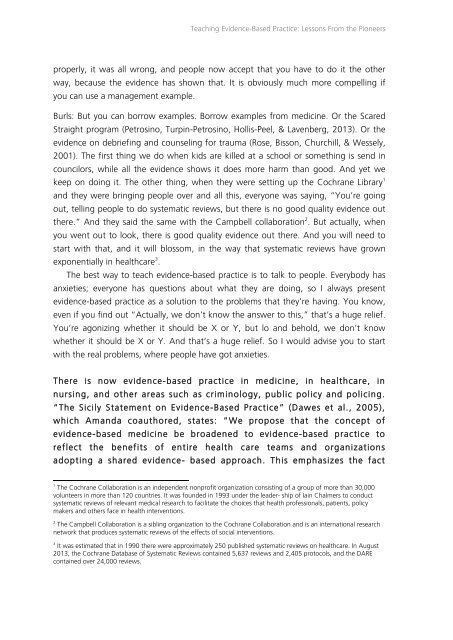In Search of Evidence
jqluvth
jqluvth
You also want an ePaper? Increase the reach of your titles
YUMPU automatically turns print PDFs into web optimized ePapers that Google loves.
Teaching <strong>Evidence</strong>-Based Practice: Lessons From the Pioneers<br />
properly, it was all wrong, and people now accept that you have to do it the other<br />
way, because the evidence has shown that. It is obviously much more compelling if<br />
you can use a management example.<br />
Burls: But you can borrow examples. Borrow examples from medicine. Or the Scared<br />
Straight program (Petrosino, Turpin-Petrosino, Hollis-Peel, & Lavenberg, 2013). Or the<br />
evidence on debriefing and counseling for trauma (Rose, Bisson, Churchill, & Wessely,<br />
2001). The first thing we do when kids are killed at a school or something is send in<br />
councilors, while all the evidence shows it does more harm than good. And yet we<br />
keep on doing it. The other thing, when they were setting up the Cochrane Library 1<br />
and they were bringing people over and all this, everyone was saying, “You’re going<br />
out, telling people to do systematic reviews, but there is no good quality evidence out<br />
there.” And they said the same with the Campbell collaboration 2 . But actually, when<br />
you went out to look, there is good quality evidence out there. And you will need to<br />
start with that, and it will blossom, in the way that systematic reviews have grown<br />
exponentially in healthcare 3 .<br />
The best way to teach evidence-based practice is to talk to people. Everybody has<br />
anxieties; everyone has questions about what they are doing, so I always present<br />
evidence-based practice as a solution to the problems that they’re having. You know,<br />
even if you find out “Actually, we don’t know the answer to this,” that’s a huge relief.<br />
You’re agonizing whether it should be X or Y, but lo and behold, we don’t know<br />
whether it should be X or Y. And that’s a huge relief. So I would advise you to start<br />
with the real problems, where people have got anxieties.<br />
There is now evidence-based practice in medicine, in healthcare, in<br />
nursing, and other areas such as criminology, public policy and policing.<br />
“The Sicily Statement on <strong>Evidence</strong>-Based Practice” (Dawes et al., 2005),<br />
which Amanda coauthored, states: “We propose that the concept <strong>of</strong><br />
evidence-based medicine be broadened to evidence-based practice to<br />
reflect the benefits <strong>of</strong> entire health care teams and organizations<br />
adopting a shared evidence- based approach. This emphasizes the fact<br />
1<br />
The Cochrane Collaboration is an independent nonpr<strong>of</strong>it organization consisting <strong>of</strong> a group <strong>of</strong> more than 30,000<br />
volunteers in more than 120 countries. It was founded in 1993 under the leader- ship <strong>of</strong> Iain Chalmers to conduct<br />
systematic reviews <strong>of</strong> relevant medical research to facilitate the choices that health pr<strong>of</strong>essionals, patients, policy<br />
makers and others face in health interventions.<br />
2<br />
The Campbell Collaboration is a sibling organization to the Cochrane Collaboration and is an international research<br />
network that produces systematic reviews <strong>of</strong> the effects <strong>of</strong> social interventions.<br />
3<br />
It was estimated that in 1990 there were approximately 250 published systematic reviews on healthcare. <strong>In</strong> August<br />
2013, the Cochrane Database <strong>of</strong> Systematic Reviews contained 5,637 reviews and 2,405 protocols, and the DARE<br />
contained over 24,000 reviews.


